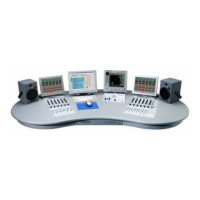OnAir Digital Mixing Consoles
Conguration 6-17
Document generated: 10.10.14
SW V6.0
• MicInsert=Off
• HPF=Off
• MicClipLimiter=Off
Mic Clip Limiter Since SW V3.0, the mic clip limiter is activated here instead of on the main
screen. It is only available for local sources; in case of a net source it is dis-
played in gray. Selections: On or Off.
OnAir 1500: Mic clip limiter not supported.
Input Location This parameter is used for the monitoring dim/cut (mute) function. Selections:
ControlRoom, Studio 1-3, none.
OnAir 1500/2500: Studios 1 and 3 not supported.
Signaling Source This parameter is used for activating the red light indication in the location
defined by the Input Location parameter of the current channel. Selections:
On or Off.
OnAir 1500/2500: Studios 1 and 3 not supported.
TBMicCut Enable Since SW V3.2, this function is configurable per logical input instead of for
the whole console at once.
If a microphone different from the internal TB mic is used for talkback, the
default selection (On) cuts this microphone’s signal from the input channel to
which it is routed as long as it is used for talkback. For special applications,
this function may be canceled when configuring Off.
Audition Bus With this parameter the contribution of the current input to the audition bus
is set On or Off.
Timer Start If this parameter is set to On, the global and the input fader stopwatches are
started when the channel to which this logical input is routed is switched ON
and its fader is opened. For details on global and input fader stopwatches refer
to chapter 5.9.
Fade In/Out Target Gain, Fade In/Out Time [ms]
If the fader should be controlled by a GP Input, four parameters must be set
here: Fade In Target Gain and Fade Out Target Gain (the default settings
are 0.0 dB and Mute, resp.), and Fade In Time and Fade Out Time (can be
set between 0 and 20’000 ms, i.e. 20 s, in millisecond steps with the pop-up
keyboard; default settings for both Fade In Time and Fade Out Time are
1000 ms = 1 s). For details on GPIO settings refer to chapter 6.5.29.
NX-Control / TB Destination Selects the owner that controls the N–X send level, or talkback to N–X, pro-
vided that the Joker Function Name (below) is set to TALK; at the same
time, the possibility to send back the own signal is disabled.
OnAir 1500/2500: Joker key not supported by the default configuration.
I/O Sharing Net Mode Logical connections may either be defined as Static (permanently reserved
for a certain signal) or Dynamic (default; used by the system only as long as
required, which is more economical).
* Codec Return Output Specifies the patch output to which the codec’s input is connected.
• Incaseofalogicalinput(netsourceis0),theConfigurationToolprovides
a list of all local logical and patch outputs.
• Incaseofanetlogicalinput(netsourcedifferentfrom0),theConfigura-
tion Tool provides a list of all logical and patch outputs of that net source.
* Codec Return Source Specifies the source that is connected to the patch output when the (net) logi-
cal input is assigned to a fader.
• Incaseofalogicalinput(netsourceis0),theConfigurationToolprovides
a list of all local N–X buses.
• Incaseofanetlogicalinput(netsourcedifferentfrom0),theConfigura-

